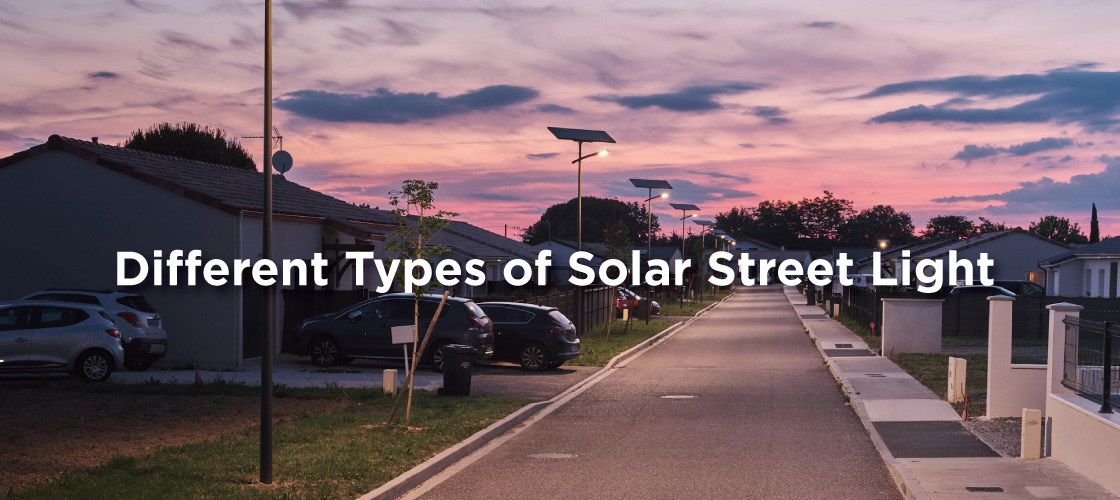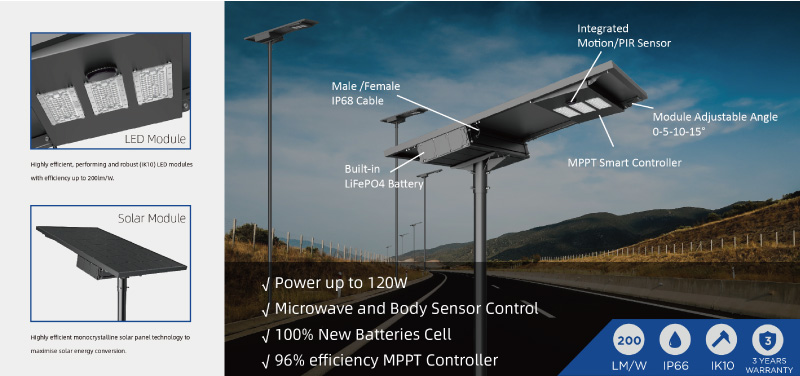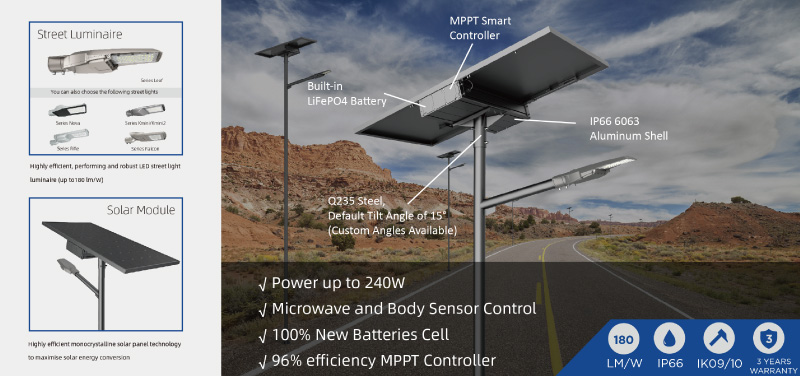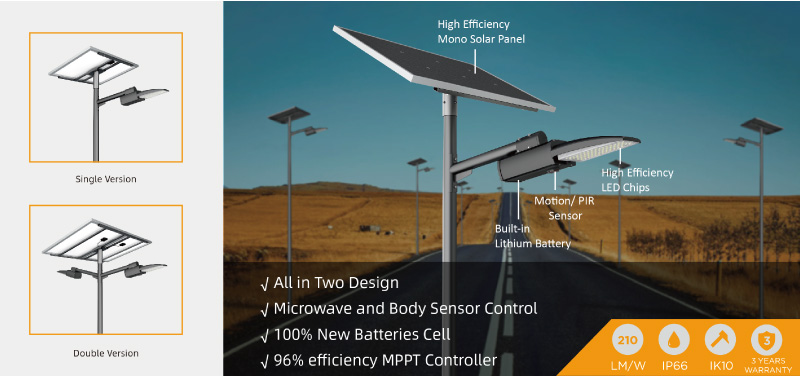
Table of Contents [hide]
1. Overview of LED Solar Street Light
2. Functions and features of main components of LED solar street lights
3. Technical characteristics of different types of LED solar street lights
3.1 Integrated solar street lights
3.3 All in two solar street light
4. Applications and advantages of solar street lights
4.1 Wide range of applications of solar street lights
4.2 Significant advantages of solar street lights
LED solar street lights are independent lighting systems that use solar photovoltaic cells to provide electricity and achieve lighting thru the photoelectric conversion principle (The advantages of solar energy). The system uses solar radiation energy as the energy source. During the day, the solar panels charge the battery, and at nite, the battery powers the LED light source. There is no need for complex and expensive pipeline laying, and the layout of the lamps can be adjusted arbitrarily. It has the characteristics of safety, energy saving, no pollution, no manual operation, stable and reliable operation, saving electricity bills and maintenance-free.
In terms of working principle, the LED solar street light system converts solar energy into electric energy thru photovoltaic effect. During the day, the solar panel absorbs sunlight and converts it into electric energy, and the electric energy is stored in the storage battery thru the controller; when the light intensity at nite is reduced to a certain value, the controller automatically starts, and the storage battery provides the required power for the LED light source to realize the lighting function. The DC controller can ensure that the battery pack is not damaged due to overcharge or overdischarge, and has the functions of light control, time control, temperature compensation, lightning protection and reverse polarity protection.
Component Name | Main Function | Technical Features | Common Types |
| Solar panels | Converts light energy into electrical energy | Conversion efficiency of 15-24%, lifespan over 25 years | Monocrystalline silicon, polycrystalline silicon |
| Batteries | Energy storage | Deep charge-discharge cycle lifespan of 3-8 years | Lead-acid battery, lithium battery |
| Controllers | System management | Intelligent switching between light-controlled and time-controlled operation, multiple protections | PWM, MPPT control |
| LED lights | Lighting functions | High luminous efficacy (100-150 lm/W), long lifespan | Integrated, split |
Integrated solar street lights (also known as all in one solar street lights) are solar street lights that integrate high-efficiency solar panels, long-life lithium batteries, high-efficiency LEDs, intelligent controllers, PIR human body induction modules, anti-theft installation brackets, etc. This design concept reflects the highly integrated and modular thinking. The components are tightly connected and have no relative movement. It not only makes the solar street lights more beautiful, but also has simple installation and maintenance, reliable operation, and can meet the use under harsh environmental conditions. The core advantage of integrated solar street lights is their ease of installation. Traditional split solar street lights require steps such as installing battery panel brackets, installing lamp heads, and making battery pits, while integrated design only requires screwing screws to install, which greatly saves labor and construction costs.
However, the integrated design also has some technical challenges. Due to its highly integrated structure, relatively large volume, and relatively heavy weight, the end connected to the lamp pole is fixed to the end of the housing during installation, resulting in the weight of the entire lamp being concentrated at the end of the housing. Thru the lever effect, the force at this point is large, and the housing is very easy to break after long-term use. Therefore, most of the existing integrated solar street lights are made of metal shells, which are costly, have large mold opening costs, and are heavier.

Split solar street lights are the traditional mainstream form, and their characteristics are that the components of the system are arranged separately: solar panels, LED lamp heads, controllers and batteries are all installed independently and connected by cables. This design allows each component to be flexibly configured according to needs, the solar panel can be oriented to the best angle to obtain maximum illumination, and the battery can be buried in the underground protection box, which increases the flexibility and adaptability of the system.
The main advantage of split solar street lights is the scalability of their technical parameters. In terms of power, the technical parameters of split solar street lights range from 10-150W, or even higher; while integrated solar street lights are generally 10-100w. This enables the split system to adapt to a wider range of application scenarios, from community roads to large roads and highways, and can provide sufficient lighting power.
Another advantage of split systems is better heat dissipation. Because the components are distributed separately, heat will not be concentrated in a closed space, which helps to extend the life of components, especially temperature-sensitive batteries and LED light sources. Studies have shown that good heat dissipation design can extend the life of LEDs by more than 20%.
However, the split design also has problems such as complex installation, more wiring, and higher overall cost. During installation, it is necessary to assemble, thread and wire, install battery brackets, lamp heads, make battery pits, etc., which is relatively complicated. At the same time, due to the need for on-site assembly, the stability of the system may be affected by the construction quality.

The all in two solar street light is an innovative design between the integrated and split types. It integrates the solar panel and LED lamp into one module, but the controller and battery may be arranged separately. This design takes into account the beauty of the integrated type and the flexibility of the split type, and is a transitional product form on the market.
The main feature of the all in two is to reduce external wiring while maintaining a certain degree of maintenance convenience. When the lamp needs to be repaired, it is easier to replace the battery or controller, unlike the integrated design that requires overall disassembly. At the same time, since the solar panel is integrated with the lamp head, there is no need for separate brackets and installation structures, which reduces wind resistance and overall weight.
In terms of market acceptance, the two-in-one design is gaining more and more recognition, especially in urban renewal projects and landscape roads, and is favored for its balance of esthetics and functionality. Many manufacturers have also launched upgradeable two-in-one systems, allowing users to replace larger capacity batteries or higher power solar panels as needed.

Urban roads and transportation facilities: Solar street lights can be used in the main streets, secondary roads and back streets of the city to provide nite lighting, reduce dependence on the city's power system, and reduce energy consumption.
Brightening of rural roads: In rural areas with weak grid coverage, solar street lights are an ideal choice, which can effectively improve the safety of nite travel. The application of solar street lights has improved the lighting conditions of rural roads, improved the quality of life of farmers, and is an important part of the construction of new rural areas.
Lighting of parks and scenic spots: Parks, squares, scenic spots and other places usually need soft and uniform lighting. Solar street lights can not only meet the lighting needs, but also blend harmoniously with the natural environment.
Industrial and commercial areas: In industrial parks and large parking lots, solar street lights can reduce operating costs and improve nite safety.
Special and remote area applications: In remote areas without stable power supply, solar street lights are a viable way to provide lighting without relying on traditional power grids.
Energy-saving and environmental protection benefits: Solar street lights use solar photovoltaic panels to generate electricity, without the need to connect to the grid for power supply, and do not consume traditional energy resources.
Economic and cost advantages: Although the initial investment is slightly higher than that of traditional street lamps, the operation and maintenance cost of solar street lamps is low, and the whole system is automatically controlled without human intervention, and almost no maintenance cost is generated.
Convenient installation and maintenance: Solar street lights do not need to lay cables or install transformers, which makes the construction complex and costly. Integrated solar street lights only need to fix the light pole, without digging trenches and wiring, which greatly reduces the construction difficulty and cost.
Safety, reliability and adaptability: Solar street lights are powered by low voltage, which is safer. Traditional street lights use 220V AC power. Once the line leaks, safety accidents may occur. Solar street lights do not rely on external power grids and have strong anti-interference ability. Even in the event of a sudden power outage or power grid failure, they can ensure lighting needs and increase the safety and reliability of lighting.
Intelligent control and advanced technology: Modern integrated solar street lights are equipped with intelligent control systems, which can automatically adjust the brightness according to environmental light, time period, human body induction and other factors. This not only saves energy, but also extends the service life of the lamps (Solar street light with motion sensor or passive infrared sensor).
|
|
|
| Series PV7 Integrated Solar Street Light | Series PV6 All in Two Solar Street Light | Series PV7 Semi Integrated Solar Street Light |
Share the Post
Add: 1-1 Dabai Road, Lin’an District, Hangzhou, 311300 Zhejiang, China.
Copyright © Hangzhou ZGSM Technology Co., Ltd. All Rights Reserved
